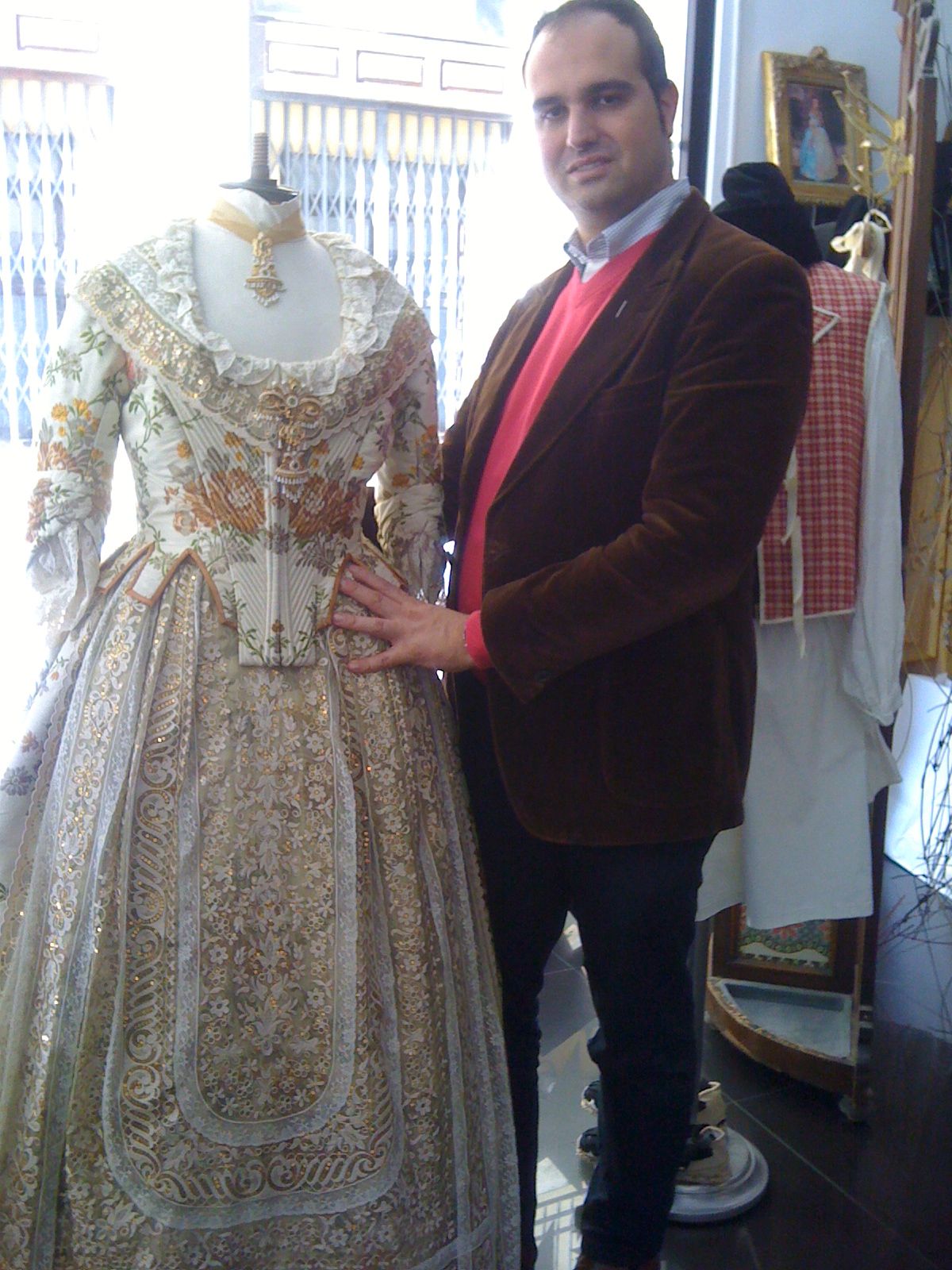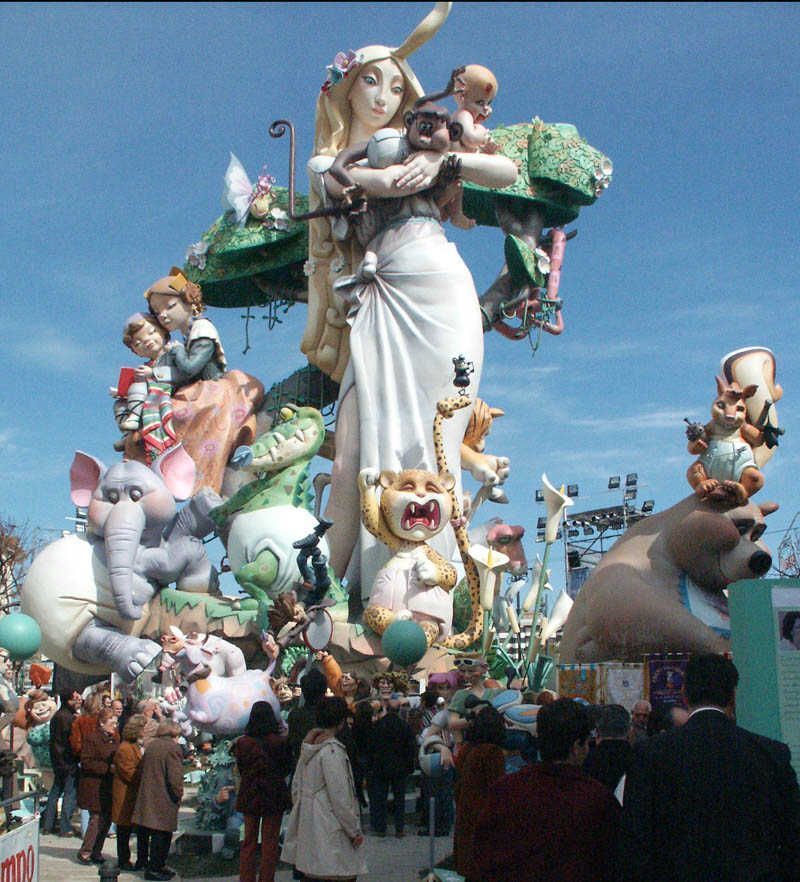Can you start by telling us a bit more about the origins of this fascinating tradition, how did it all start?
There are no records of the origins of the Fallas, so there are many different theories about how they began. The accounts that we take to be the most reliable are that. Firstly; on the 19th March, the day of the Feast of St. Joseph, carpenters would burn the ‘parots’ (wooden structures they used to hang oil lamps on so they would have light in the short winter days), in the streets outside their workshops and then the Fallas evolved from the burning of these wooden structures, then puppets and satirical images were added until the Fallas that we have come to know were created. Another theory is that people used to create puppets to satirise characters from their neighbourhood, which were carried around their town and burnt.

Ernesto Sostoa shows us some of the beautiful Fallas costumes at his studio in Valencia.
What do you think makes this festival different from other similar festivities?
For me the monument is the heart of the Fallas; the essence of the festival, it´s everything, it´s where the Fallas began and where they get their name from. For me it is the greatest form of ephemeral art that exists in the world, because it is art that is created to be burnt, I think this is what makes the Fallas unique. The monuments can cost anything from 3500 euros to 1,000,000 euros and take a whole year to prepare, beginning with a drawing, then a model is developed from this drawing which is then used to construct the life size falla, which is then painted and decorated, so that on 15th March it seems like the fallas have magically risen from the ashes of the fires to be exhibited in every corner of Valencia once again. There are as many as 400 fallas, so often you can stand at various points in the city and do a 360° turn and spot between 4 or 5 fallas in the distance.

What happens during the week of the Fallas? What events take place?
The festival is made up of many different events, including the parades, which attract a lot of tourist attention in particular; they are very well organized, captivating and beautiful. The whole of the Fallas commissions are dressed in the traditional regional costume and are accompanied by orchestras, playing the traditional music of Valencia. These bands often come from outside the province to play in the Fallas and always accompany the commissions; it is a very beautiful musical and expressive event. Another significant event is the prize giving ceremony at the Plaza de Ayuntamiento, where the Falleras Mayores of Valencia hand out awards to the commissions.
Then there is also the Flower Offering Event, one of the key events of the Fallas week. It is celebrated during the 17th and 18th March. The 400 fallas commissions pass through the centre of the city to bring flowers to the Virgin planted at the Plaza de la Virgen; the event lasts from 3:30pm – 1:30am which gives you an idea of the magnitude of this event, we are literally talking about tons and tons of flowers. In fact, when you walk through the streets that lead to the Plaza de la Virgen, there is deep smell of flowers because there is simply huge mountain of flowers. Another aspect which distinguishes the fallas from other festivals are the fireworks of the Mascleta, which takes place every day at 2pm from the beginning of march at the Plaza del Ayuntamiento. It is like a 5 minute earthquake of such an incredible scale that there are moments you think the world is going to end because there is so much smoke that you can´t see anything and the sky turns black. It is an incredibly intense moment particularly for the people of Valencia. There are also fireworks in the evening, characterised by their great variety of colour; they are very lengthy and noisy displays that last at least 30 minutes, a unique fusion of colour and noise.
The Fallas have a great impact on tourists; I think this is mainly because of their splendour. It is a very intense experience; it is impossible to sleep for those 6 days because there is so much going on, you are either celebrating or taking part in one of the events.
You mentioned the Falleras Mayores a few times; can you tell us a bit more about them, who they are and their role in the fallas?
The Fallera Mayor is the highest representative of Valencia; she is like the Queen of Spain to the people of Valencia and a great authoritative figure, representing the city at every level. For the entire year of her reign, she must be at the service of the people of Valencia; all events are led by her both in the city and outside of the city. For the selection process, each of the fallas commissions nominates a candidate and then there is a selection process until there are just 13 candidates left from which the Fallera Mayor of Valencia is chosen around mid-October.

What does your job as a designer of the Fallas involve?
When people refer to me as a designer of fallas costumes, it makes my ears ring, because my job is really to reproduce versions of the garments that our ancestors wore, the garments I make are replicas of them. They are immensely beautiful and highly valued articles of clothing, having been accredited as the most luxurious garments that existed in the whole of Europe at a competition that was held in Italy in the 1980s. They can cost anything from 2000 Euros to 400,000 or even 500,000 Euros to make, as the textile used to create them is handmade and incredibly costly. The gowns we produce consist of a very tight corset, with a full skirt and sleeves just below the elbow and a lace collar which comes from the shirt that is worn underneath the dress. There is also the fallera dress, which comes from the 19th century and has lantern sleeves; it is a more modern gown which was originally worn by Pepita Samper, the first Fallera Mayor of Valencia. When people see these dresses for the first time, they are utterly captivated by them.












